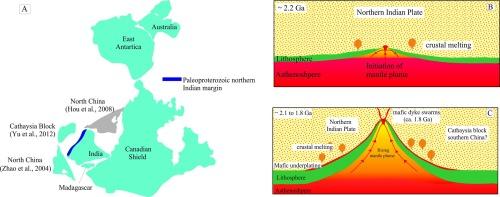Tectono-magmatic evolution of the Indian crust in western Himalayas during Paleoproterozoic: Insights from Nanga Parbat and Indus syntaxis in northern Pakistan
IF 7.2
1区 地球科学
Q1 GEOSCIENCES, MULTIDISCIPLINARY
引用次数: 0
Abstract
The Paleoproterozoic tectono-magmatic history of the Indian plate has been modelled mostly based on investigations of the Indian parts with limited studies considering the Pakistani domains of the mountain range. In this study we investigate basement rocks and younger intrusions of the Indian crust from within the core of the Indus Syntaxis and the Nanga Parbat Syntaxis in northern Pakistan, with the goal of establishing a chronology for the entire tectono-magmatic progression of northwestern Indian plate margin, including the source rocks that were ultimately involved in the formation of younger magmatic pulses. We present in-situ zircon U-Pb geochronology and O-isotopes complemented by whole rock geochemistry of granitoids and paragneisses that yielded evidence for two distinct, large-scale Paleoproterozoic magmatic events that took place in ∼ 1860 Ma and ∼ 2200 Ma in the Indian crust. Later, leucogranites (6.4 ± 0.1 Ma) intruded into the Nanga Parbat basement that were the result of melting of the basement induced by rapid uplift. The δ18OSMOW compositions of zircons from our basement samples range between 7.5 to 9.1 ‰, indicating the derivation of parental magma from the crustal source while the younger leucogranite is somewhat lighter with δ18O ranging between 7.06 to 8.23 ‰. Geochemical data show extensional tectonic settings for the basement rocks that have an A-type affinity, again pointing to a crustal precursor. We propose little to no δ18O exchange took place between the young anatectic melt and basement rocks during crustal evolution. Moreover, geochemical signatures record the crystallization of basement rocks dominated the northwestern margin of Indian plate in a post-orogenic setting in an overall extensional tectonic realm. Based on these observations, we infer that the northwestern Indian margin has experienced a large-scale magmatism during Paleoproterozoic associated with the amalgamation of the Columbia supercontinent.

古近古生代喜马拉雅山西部印度地壳的构造-岩浆演化:从巴基斯坦北部的南迦帕尔巴特山和印度河综脉获得的启示
印度板块的古新生代构造-岩浆史模型主要是基于对印度部分的研究,而对巴基斯坦境内山脉的研究有限。在这项研究中,我们调查了印度地壳的基底岩石和较年轻的侵入体,这些岩石来自巴基斯坦北部的印度河综合地轴和南加帕尔巴特综合地轴的核心区域,目的是为印度西北板块边缘的整个构造-岩浆演化过程建立年表,包括最终参与形成较年轻岩浆脉冲的源岩。我们展示了原位锆石U-Pb地质年代学和O-同位素,并辅以花岗岩和片麻岩的全岩地球化学,这些证据表明印度地壳在1860Ma∼和2200Ma∼发生了两次不同的、大规模的古新生代岩浆事件。后来,白云岩(6.4 ± 0.1 Ma)侵入南迦帕尔巴特基底,这是快速隆升引起基底熔化的结果。基底样本的锆石成分δ18OSMOW介于7.5至9.1‰之间,表明母岩浆来自地壳源,而较年轻的白榴石成分较轻,δ18O介于7.06至8.23‰之间。地球化学数据显示,基底岩石具有A型亲和力的延伸构造背景,这再次表明了地壳的前身。我们认为,在地壳演化过程中,年轻的无极性熔体与基底岩石之间几乎没有发生δ18O交换。此外,地球化学特征记录了印度板块西北边缘基底岩石的结晶过程,该过程是在整体伸展构造背景下的后成因环境中进行的。根据这些观察结果,我们推断印度西北边缘在古近古生代经历了与哥伦比亚超大陆汞齐化有关的大规模岩浆活动。
本文章由计算机程序翻译,如有差异,请以英文原文为准。
求助全文
约1分钟内获得全文
求助全文
来源期刊

Gondwana Research
地学-地球科学综合
CiteScore
12.90
自引率
6.60%
发文量
298
审稿时长
65 days
期刊介绍:
Gondwana Research (GR) is an International Journal aimed to promote high quality research publications on all topics related to solid Earth, particularly with reference to the origin and evolution of continents, continental assemblies and their resources. GR is an "all earth science" journal with no restrictions on geological time, terrane or theme and covers a wide spectrum of topics in geosciences such as geology, geomorphology, palaeontology, structure, petrology, geochemistry, stable isotopes, geochronology, economic geology, exploration geology, engineering geology, geophysics, and environmental geology among other themes, and provides an appropriate forum to integrate studies from different disciplines and different terrains. In addition to regular articles and thematic issues, the journal invites high profile state-of-the-art reviews on thrust area topics for its column, ''GR FOCUS''. Focus articles include short biographies and photographs of the authors. Short articles (within ten printed pages) for rapid publication reporting important discoveries or innovative models of global interest will be considered under the category ''GR LETTERS''.
 求助内容:
求助内容: 应助结果提醒方式:
应助结果提醒方式:


